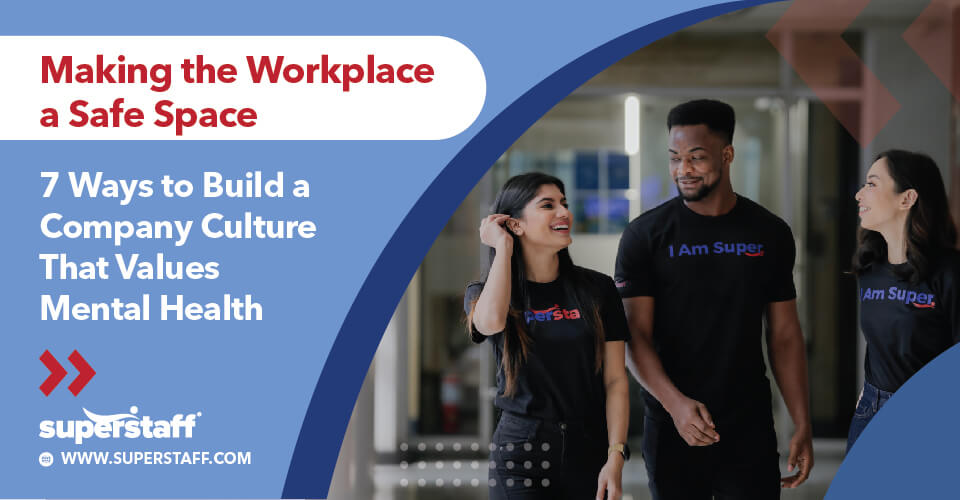
Mental health awareness in the workplace matters as many employees see it as a factor in whether to stay or leave. Its weight became apparent at the height of COVID-19. And as businesses emerge from the pandemic, decision-makers should learn from what has transpired.
Millions of workers quit their jobs as the stress of possible infections, death of loved ones, and lockdowns have taken their toll. Irregular hours and increased demands at home ultimately pushed employees to the edge and left jobs in droves, henceforth creating widespread labor shortages and pushing The Great Resignation across industries.
The pandemic is in the rearview mirror, but the issue of prioritizing employee well-being for businesses remains. It is high time to push for mental health in the workplace.
Top 7 Ways To Support Mental Health Awareness in the Workplace This 2022

Advocating employee wellness initiatives will set businesses apart from their competitors. Being attractive to jobseekers and employees this way can cushion you from the impacts of The Great Resignation. Studies show that job seekers and employees prefer companies that prioritize well-being in the workplace.
One study found that 70% of employees engaged in wellness programs showed higher job satisfaction. Another research found that about 86% of employees getting treatment for depression showed improved job performance. These numbers hint that with strong mental health programs in place, you can reduce employee churn.
If you aren’t sure how to start championing mental health in your workplace, SuperStaff rounded up some excellent recommendations.
#1: Create a “check-in” culture that fosters community and connection.
How well do you know your staff? Do you know about their interests? When was the last time you asked them about their families? Most importantly, how are they these days?
We may think we are setting boundaries by not asking about our employees’ personal lives, but these “boundaries” could alienate them from the workplace. One study found that of 40% of global employees who weren’t asked about their well-being at work, 38% are more likely to suffer mental health issues.
Instead of creating barriers, we should be breaking them with a workplace check-in culture. Getting to know our employees and building relationships with them is a great way to motivate them.
The next time you notice an employee is struggling with their tasks, try asking, “how are you doing?” rather than “how is work?.” Whether they’re facing personal problems or work stress, it helps to know that their boss and colleagues are always ready to lend an ear.
#2: Provide easy access to mental health resources and the Employee Assistance Program.
A lot of companies offer employee wellness and employee assistance programs (EAP). Unfortunately, internalized stigma against mental health often keeps employees from seeking the support they need, even if it’s readily available.
Workers fear they will be perceived as unreliable if they avail of these programs. While there is no quick fix to the mental health stigma, you can start by raising awareness of the programs and resources you have for them.
On the other hand, employees may not fully understand how EAP and other employee well-being programs work. Cluelessness adds to their reluctance to avail of the programs.
Make it your duty to assure your staff of confidentiality. For instance, if you have a resident psychiatrist, emphasize the doctor-patient confidentiality clause. This can help ease fears about judgment when they seek mental help.
#3: Reframe performance reviews as opportunities for feedback and learning rather than focusing strictly on numbers.
Do your employees see performance reviews as a chopping block rather than a jump-off point? Perhaps the reason behind this is an impersonal approach.
When an employee’s performance suffers, our first instinct is to check their KPIs. In doing so, we fail to get to the root of the problem. Sure we can make strategies to get the numbers up. But, these are just band-aid solutions that won’t work unless we motivate them.
A little empathy will go a long way. We can frame pain points as growth opportunities. Let them weigh in on their career trajectory. Hear out their thoughts on boosting productivity and improving the workplace culture.
Their performance review shouldn’t be a pass or fail test. It should be about planning their future in the company and helping them achieve it.
#4: Be proactive in offering mental health awareness and training.
Mental health is shrouded in stigma. One common myth is that people with mental health illnesses are unstable and violent. Some people even think these conditions are “all in the head” and that people who suffer from them want attention. Some believe that positive thoughts can overpower mental health illnesses.
With so many misconceptions, it’s our role as employers to debunk these and educate our employees on the issue. Mental health should not be considered taboo in the workplace, especially since work is a factor in common illnesses such as stress and burnout.
There are many tools at our disposal that we can use to raise awareness. We can introduce inclusive policies to prevent workplace discrimination. Equally essential is training our managers to prioritize mental well-being.
Health and wellness seminars can also equip our employees with the necessary coping and self-care skills for mental health illnesses. They can also benefit from health programs such as yoga and exercise classes at the office.
#5: Provide avenues for engagement and stress reduction.
The workplace should be a safe space, and yet, research shows that a staggering 94% of workers are stressed at work. Almost a third of them report having high-stress levels.
The office should not have to be a place that our employees dread. We can bring down our staff’s stress levels by creating physical spaces that promote wellness, such as meditation and mindfulness rooms.
An emotionally safe environment is also about the culture we promote. We need more opportunities for genuine connections with each other. This can take the form of mixers, team-building activities, and other social events.
We can also initiate peer and emotional support groups to strengthen bonds among our employees, such as gay-straight alliances, sports teams, and hobby-based clubs. Meanwhile, electronic message boards can serve this purpose for remote workers.
All these programs will act as support systems that employees can lean on when they feel burdened by work and personal problems.
#6: Take a holistic approach to employee well-being by prioritizing compassionate leadership and greater flexibility.
The post-pandemic landscape is a transition period that comes with a lot of birthing pains. Businesses are not the only ones affected. Employees are struggling too. In these difficult times, our silence about the challenges they face can be deafening to our employees.
Adapting to the new norm means reimagining new ways to show our employees that we care. We can do this by offering more flexibility, sending care kits, or starting remote employee wellness programs. Training them to delineate their jobs from their personal lives while working at home is also crucial.
But most importantly, they need compassionate leaders. This could mean supporting employees in times of grief, lessening their workload when they are overwhelmed, or offering paid leaves. Sometimes, it’s just being a friend they can vent to.
Read more: Compassion as a Compass: How SuperStaff Navigates the Challenges of Leading in the New Normal
#7: Make mental health care more accessible to your employees.
Did you know that an overwhelming majority (67%) of employees who suffer from mental illnesses have difficulties accessing the care they need? With so many innovative ways to access health care nowadays, this should no longer be an issue. But, sadly, it still is.
We can start by opening up all possible avenues for our employees to seek help on their terms. For instance, we can bring mental health professionals to the office regularly. We can also boost the number of counseling and therapy sessions covered by their HMO. Another option is providing them with subscriptions to telepsychiatry and other mental health apps.
On top of these, we can offer subsidized clinical screenings for mental health concerns and accessible or affordable prescription medication.
Make Well-Being at the Workplace a Priority
Organizations need to recognize that designing a comprehensive program that promotes all aspects of employee wellness, from physical to emotional health, should now be a priority. These health initiatives drive job satisfaction and employee growth. Your employees are what fuel your company. Ensure they have a safe place with a culture that values them more than anything else.






